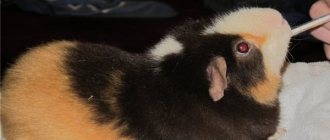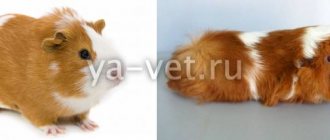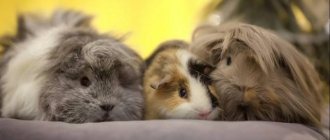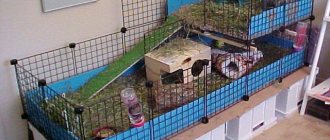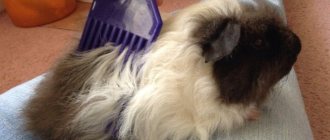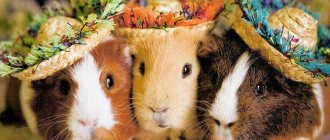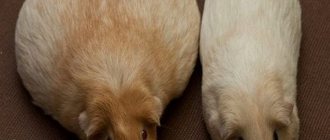- home
- Guinea pig
- Guinea pig health
02/06/2019 A guinea pig can catch a cold if the rules for keeping the pet are violated. Owners of a delicate animal need to know what to do in such cases and how to recognize the disease at an early stage. This is very important when it comes to a small pet. Knowing the symptoms of a cold gives you a chance to start treatment in a timely manner.
What can cause a pig to have a cold?
Rodents naturally have strong immunity. It is weakened if the conditions of detention are violated and the diet is formulated incorrectly.
The causes of a cold can be the following:
- the pet’s cage is in a room where the temperature is below +18℃ and hypothermia occurs;
- the rodent has been in a draft or near a working air conditioner;
- after bathing, the animal was not dried enough and was wet for a long time;
- There was raw filler in the cage for a long time.
A cold in a guinea pig can occur after contact with a sick person. Therefore, you should not handle the animal until it recovers.
Treatment for tympany
The process is long, and efficiency depends on the scrupulousness of the owners.
1. Avoid all succulent foods during the recovery period.
2. Give probiotics as prescribed.
3. Introduce vitamin C into your diet.
4. Promote the activity of the animal.
Greens should be introduced gradually. First, they give you a piece of dried apple and a slice of carrot. It is necessary to ensure regular feeding of the following products:
- stems of fennel, artichoke, leaves of dill, parsley, basil;
- seeds of dill, anise, cumin;
- meadow herbs: chamomile, yarrow, dandelions, nettle.
How to recognize a cold in a mumps
If you pay close attention to your pet, you can immediately notice the signs of a cold:
- the animal is lethargic and does not want to drink or eat;
- sneezes and rubs the nose area;
- breathing becomes heavy and uneven;
- coughs and wheezing is heard;
- eyes become red and swollen;
- mucus comes from the nose and eyes;
- the rodent freezes in one position for a long time;
- the fur becomes dull and ruffled;
- body temperature rises.
The pet needs to be taken to the vet immediately. To treat on your own means to expose yourself to the risk of complications.
A runny nose in a guinea pig is not a harmless symptom of a cold. It is necessary to immediately clear the nasal passages of mucus to allow the animal to breathe normally and prevent the infection from spreading to the lungs.
Parasitic diseases
Do rodents have parasites? Pigs often suffer from parasitic diseases, mainly coccidiosis.
- Fascioliasis. The causative agents of the disease are flatworms from the group of flukes that infect the liver. It is possible to understand that the pig is sick only at a late stage of helminthiasis, when it is no longer possible to save the pet. The dying pig is lethargic, apathetic, does not eat or drink.
- Coccidiosis. The causative agents of the disease are single-celled parasites from the genus Coccidia. The infection is transmitted through poor-quality food. A sick pig is lethargic, does not want to eat, suffers from bloating, and does not poop. Instead of normal feces, liquid mixed with mucus and blood flows out of the anus. For treatment, the drugs Himcoccid, Ditrim, Furazolidone, Sulfadimezin are added to the drink.
- Trichomonosis. Intestinal pathology provoked by single-celled parasites. An infected rodent has profuse bloody-mucous diarrhea, and the oral cavity is covered with a yellow coating. Therapy is carried out quickly, otherwise the pet may die from lack of air due to damage to the mouth. For treatment, Metronidazole is added to the feed.
- Oxyurosis. The disease caused by roundworms has no obvious symptoms. Sometimes you may notice that the pig has lost weight and is defecating liquid mixed with blood. For treatment, Fenbendazole, Piperazine, Thiabendazole are used, the drugs are mixed with food or drink.
- Skin parasites. Most often, pigs become infected with fleas. An infected animal experiences dermatitis, accompanied by baldness, redness and irritation of the skin. Due to severe itching, the rodent twitches, jumps, and itches until it bleeds. The subcutaneous mite and the lice beetle are parasites that usually infect pigs living in crowded nurseries. To remove bloodsuckers, antiparasitic ointments, aerosols, and shampoos are used.
Guinea pig snot
Nasal discharge in rodents can be of both an allergic and cold nature. This is how rhinitis of infectious origin, bronchitis and pneumonia manifest themselves.
Allergic snot in a guinea pig is liquid and transparent. These include red eyes, tears flowing, a rash appears on the skin, and hair begins to fall out. Allergens include:
- Filler;
- missing feed;
- meadow grass hay;
- houseplants;
- the use of chemical detergents to clean the cage;
- dust in the room;
- other pungent odors in the room.
If the pig is kept in an aquarium, then snot is possible from heavy fumes that come from the litter.
Allergens should be excluded and the pig should be given an antihistamine for children in liquid form. With a cold or infectious rhinitis, the animal snorts, touches its muzzle, and purulent mucus comes out of the nose and eyes.
A cold in small rodents can very quickly turn into pneumonia. To prevent the animal from dying, it must be treated immediately. First aid is to rinse the nose with chlorhexidine, which will prevent the cold and infection from going further. Instilling Derinat drops for children also helps.
For a purulent runny nose, streptocidal powder is blown into the nostrils. Specialists usually prescribe antibiotics or sulfonamides to a sick animal.
Signs of a Dying Pet
If the guinea pig is healthy, nothing bothers it, the food is good, there is water and there is no reason for stress, it will be constantly on the move, actively eat food, its eyes will be shiny, and its behavior will be friendly. Such a pet responds with pleasure to games and is distinguished by cleanliness.
If a guinea pig dies, this can be determined by characteristic signs:
- Dull gaze, cloudy cornea;
- coordination of movements is severely impaired, the animal limps, limps, its movement around the cage is difficult, it often falls to the side for no apparent reason;
- completely or partially refuses food (even if she is offered her favorite treat), stops drinking water;
- instead of the usual active movements, the pig sits for a long time in a hunched state, on its back or on its side;
- rapid breathing, wheezing may be heard;
- the animal stops responding to external stimuli, does not notice the owner, tries to hide in the far corner of its home;
- the animal becomes unclean and stops cleaning its coat;
- hair falls out in large quantities, bald patches appear;
- lumps of unknown origin may be felt under the skin;
- the joints of the limbs and fingers become noticeably thicker.
Even if there are none of the listed symptoms, but it becomes noticeable that the animal sleeps most of the time, you should be wary.
Why does a guinea pig cough?
A cold is not complete without symptoms such as a cough in an animal. This is a protection that works to cleanse the respiratory channels.
A cough indicates the following troubles:
- There is something stuck in the animal's throat;
- bronchopneumonia, colds;
- dental diseases;
- damage to the animal's body by parasites;
- cardiac disorders.
An animal's cough always has a serious cause, which requires immediate contact with a veterinarian.
What to do if your guinea pig has bronchitis
Bronchitis indicates a complication of a cold. Dust, smoke in the house, very low air temperature in the room, bacteria and parasites provoke a cough.
With bronchitis, the cough is intense and hard. A sick animal does not drink water; purulent mucus comes from the eyes and nostrils. If the animal is not treated, it will die.
The veterinarian will prescribe what to treat for bronchitis. Usually these are anti-inflammatory medications that enhance immunity, vitamin preparations, and phlegm removal products.
Pneumonia in a guinea pig
The consequence of an untreated cold in 90% of cases is pneumonia. In young animals this occurs in the cold season.
Causes:
- Drafts;
- increased dampness and cold;
- temperature changes;
- unsuccessful transportation;
- poorly thought out poor nutrition.
All this occurs against the background of a lack of vitamins, including C, when the animal does not receive enough fresh food enriched with vitamins.
Pneumonia can be acute or chronic. In the first case, the course is rapid and the animal dies due to high temperature, damage to the body by toxins and exhaustion.
The chronic form also shortens the pet's life expectancy. Against the backdrop of a sharp decrease in immunity, the animal gets sick more often and loses weight.
Symptoms indicate pneumonia:
- Refusal of water and food;
- cough (dry or wet);
- wheezes when breathing, whistling and gurgling are heard;
- lethargy, depressed state;
- no reaction to the owner’s voice;
- the nose becomes covered with dry crusts;
- eyes red, swollen, stuck together;
- the coat looks sloppy;
- lethargy and drowsiness.
Treatment occurs only under the supervision of a veterinarian. There is no need to hope for temporary improvements, which are quickly replaced by a sharp deterioration and death of the animal.
Non-communicable diseases
Below are descriptions with photos of the main non-infectious pathologies characteristic of mumps.
- Cystitis. A pig suffering from cystitis is anxious, does not go to the toilet, and does not drink water. Attempts to empty the bladder cause pain, and blood is noticeable in the urine. Treatment is carried out with antibiotics and antispasmodics.
- Ovarian cyst. The disease is asymptomatic and therefore often leads to death. In rare cases, a sick pig will shed on both sides of the body. A cyst can only be detected through ultrasound. The only treatment method is surgical removal. The tumor is excised along with the uterus and appendages.
- Injuries. Why do pet pigs get wounds and scratches? The fact is that rodents, especially those living crowdedly, often sort things out, bite and scratch each other. The animal can also scratch its skin on the bars of the cage or damage the soles of its paws on the grated floor. Calluses and abscesses are visible on damaged paw pads. The animal staggers when walking, prefers to lie down, and you can notice that its paw is swollen. To avoid an abscess, the wound should be washed daily with a solution of potassium permanganate or 3% hydrogen peroxide, treated with Streptomycin ointment or Vishnevsky ointment, and covered with a bandage. The bottom of the cage should be solid, not lattice.
- Pododermatitis. Inflammatory disease of the heels in pigs, often leading to death. A sick animal limps, its paws become bald, its pads become swollen, red, and covered with ulcers. What causes the disease? The main reasons are vitamin deficiency, poor sanitary condition of the cage, foot fungus, obesity and a sedentary lifestyle. Treatment is carried out with Levomikol ointment for wound suppuration, Dermatol powder for ulcers, and Topic spray for bleeding.
- Rickets. Caused by vitamin deficiency, poor quality diet, lack of sun. A sick pig has a perverted taste: it chews bedding, cage bars, toys. In advanced cases, the animal’s legs and spine become bent, joints thicken, and convulsions occur. The fur becomes dull, clumps, and dandruff appears. What to feed your pet to get rid of rickets? It is necessary to give more hay and fresh greens, add vitamins and minerals, especially calcium, to the food. If a pig drinks a lot of water, then it does not have enough succulent food.
- Heart diseases. Stroke, myocardial necrosis and other diseases of the cardiovascular system are rare in pigs. Heart function is disrupted mainly due to stress and uncomfortable temperature conditions. To prevent your pet from getting sick, it should live in a quiet and shaded place where the air temperature ranges from 22 to 25°C.
- Eye diseases. A pig's eye usually becomes infected with conjunctivitis. You may notice that the pet squints, is afraid of the light, his eye is swollen, tears and pus flow, and crusts appear on the eyelids. If the infection spreads to the muzzle, cheilitis develops. Treatment is prescribed by a veterinarian based on the cause of conjunctivitis. When the cornea is injured, keratitis develops. The cornea becomes cloudy, and the rodent's vision weakens. Therapy is carried out with antibiotic drops. Sometimes you may notice white discharge from your pig's eyes. These are tears. The animal is stressed, scared and crying.
- Otitis. When the ears are inflamed, the pig becomes nervous, shows aggression, lowers its head to the side or down, and shakes it. A crust of dried blood is noticeable inside the sore ear. What to do if your pet has otitis media? Surolan is instilled into the ears; it is additionally recommended to treat the ears with Miramistin or Chlorhexidine.
- Tumors. Most often, rodents develop cancer of the mammary glands and skin. A malignant tumor forms on the abdomen or back and looks like a lump. Rarely, the neoplasm appears as a spot on the hind legs. Oncology is excised without consequences, but cancer on the hind legs can metastasize. A tumor on the neck or back may turn out to be a harmless wen - a lipoma.
If your pig is breathing heavily and wheezing
A cough does not always indicate diseases of the bronchopulmonary system. Sometimes this indicates cardiac pathology.
The animal needs quick help and advice from a specialist.
Symptoms of heart failure:
- The pig gasps for air;
- breathing heavily;
- periodic coughing;
- shortness of breath when moving;
- immobility develops;
- lethargy and apathy;
- paws are cool;
- fingers turn blue;
- coordination of movements is impaired;
- convulsions.
To stop heart and asthmatic attacks, you need to immediately drop 2 drops of Corvalol into the mouth and then let the animal smell cotton wool soaked in aroma oil. The animal is given an injection that includes aminophylline, dexamethasone, and furosemide.
They treat heart failure for a long time, maintaining vitality.
Heart drops are administered to the rodent using an insulin syringe with the needle removed.
An animal suffering from heart failure needs proper nutrition and good living conditions.
At the first symptom of illness, treatment should begin. The speed of recovery depends on the speed of contacting a veterinarian.
How to treat
A veterinarian should treat your guinea pig for a cold. The animal is undergoing treatment with medications: baytril, sulfazine. First, they look at the pet’s reaction to these drugs. In parallel, Linex or other drugs with bifidobacteria are prescribed.
Wash the nasal area with chlorhexidine. Inflamed eyes are washed with saline twice a day and Tsiprovet or Tsipromed are instilled.
The most important thing is cleanliness around the animal, fresh air, and absence of drafts. Expectorant herbal decoctions give good results. Sometimes it is advisable to give the animal a drop of a syrup-like medicine for children (Bromhexine).
